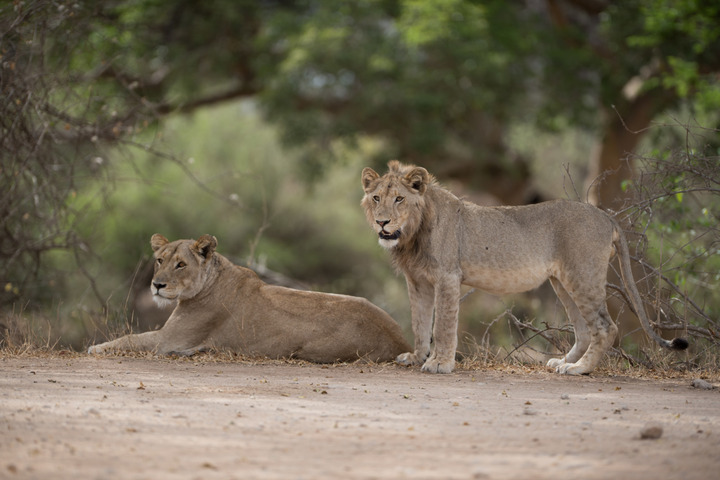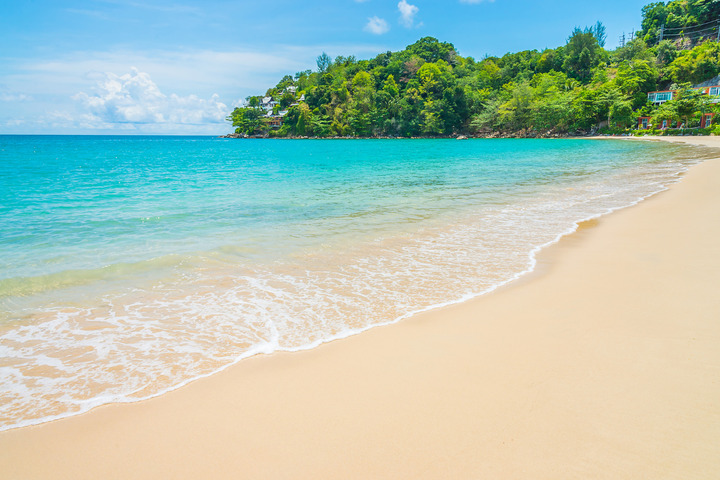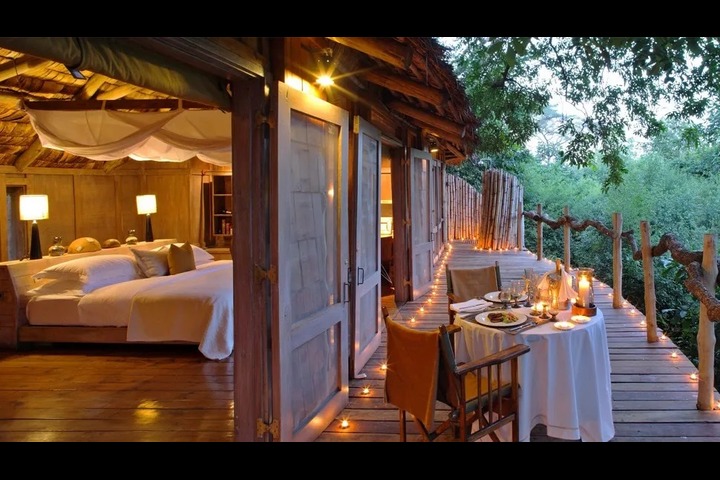Your Tanzania vacation welcomes you into an epic tale of nature where scenic landscapes shift from lush greenery to arid plains and back again. But your visit’s timing can dramatically alter your vision of this grand drama.
Whether you’re keen to witness the great wildebeest migration or spot predators in action amid Tanzania’s thriving ecosystems, you need to be aware of the best time to visit Tanzania for a Safari.
Nonetheless, you’re in for a treat!
Birdwatching, cultural revelations, African luxuries, and adrenaline-pumping adventure, Tanzania is a safari paradise in its truest sense.
The Climate of Tanzania

Tanzania’s climate is as varied as its majestic landscapes, ranging from humid coastal regions to arid zones in the north. Not to forget the captivating highlands in the northeast and southwest. Knowledge of seasonal patterns and weather conditions can help you understand wildlife behaviors.
- The peak season for wildlife viewing is June- October because of clear skies and lower humidity. While the temperatures are generally cooler for game drives, it’s easier to spot animals in the thinner vegetation of this dry season. Even better, this season coincides with the Great Migration’s dramatic river crossings in the Serengeti.
- Next, consider the wet season, which splits into short rains during November and December and long rains from March to May. These months push the landscape switch to a greener canvas dotted with wildflowers and dense vegetation. Though this can make animal-spotting hard, you’ll cherish the beautiful sights of migratory birds in abundance.
- The transitional period bridges the months from May to October and offers the best of both worlds. The landscape begins recovering from the dry season at the end of May, and in October, it subtly shifts toward dryness. Both of these options offer tempting opportunities for wildlife sights and photography.
Wildlife Viewing in Tanzania
Here is what East Africa’s Tanzania holds for wildlife viewing enthusiasts.
1. The Great Migration

Among nature’s grandest events, the Great Migration hosts 1+ million wildebeest with hundreds of thousands of zebras and gazelles. They traverse the Serengeti ecosystem in predictable patterns, looking for fresh grazing and water.
The herds stomp towards the Western Corridor of the Serengeti around May/June, making jam-packed river crossings in the following months. Finally, they migrate northwards to the Mara River.
What’s best is that you’ll see sights of predators like lions, hyenas, and crocodiles initiating nail-biting wildlife encounters.
2. The Big Five

This name was derived after big game hunters identified lions, leopards, elephants, buffalos, and rhinos as the hardest animals in Africa to hunt on foot.
Consider Tanzania’s northern circuit parks of the Serengeti and Ngorongoro Crater to catch the Big Five in action.
Consider stopping by the Ngorongoro crater for longer in season time to view a large populace of black rhinoceros. They’re typically the least spotted among the Big Five in the wild.
3. Other Wildlife
The country houses a rich variety of wildlife reserves and national parks.
Tarangire National Park is popular for elephant herds and iconic baobab trees. Also, less-visited southern wildlife reserves like Ruaha and Selous are home to large packs of wild dogs and sable antelopes.
Similarly, Gombe Stream and Mahale Mountains National Parks let travelers watch chimpanzees celebrate life in their organic habitats.
What is the Best Time to Visit Tanzania For a Safari?

You must learn about the ecological zones and fluctuating climatic conditions to choose the best time to visit Tanzania for a safari holiday. Whether traveling solo or with your family, here’s a breakdown for all you adventure seekers:
High Season: June to October
June to October is when you want to ideally visit Tanzania. Minimal rainfall and cooler, pleasant weather conditions make it easier to spot wildlife.
The limited water sources also increase accessibility to several regions where wildlife is usually roaming and living.
The Great Migration occurs during this season, drawing tourists to the Serengeti and Ngorongoro Crater for reliable sightings of the Big Five. Not to forget, the rainfall shortage reduces Malaria risks and makes it ideal for visitors.
Lastly, expect higher prices and more crowded safari sites since this is the busiest time.
Shoulder Season: November to March
The shoulder season is ideally the period between seasonal and non-seasonal times where fares for safaris, accommodation, and travel are lower than average.

Note that this season promises a more nuanced safari experience. The early parts of the season bring short rains and a fresh burst of life to each landscape – a photographer’s dream.
Though not in full throttle, wildlife is still plentiful. You’ll be at peace on your safari adventure when viewing the birthing season in late January and February.
Low Season: April to May
These months see monumental rainfall, making small roads in safari parks impassable. The better half of lodges, homestays, and campsites also close temporarily.
However, this off-season duration welcomes dramatic transformations in the bushes, calling for intense greenery and abundant freshwater.
Those willing to compete with the weather unpredictability of this season can enjoy a deeply rewarding safari experience.
Where to Go for Safari in Tanzania
· Serengeti National Park

The Serengeti National Park is a UNESCO World Heritage site that spans over 5,599 sq. miles. Its landscape stretches from savannahs and riverine forests to hills, supporting numerous animal species inhabiting the park.
You’ll see kopjes scattered in the Serengeti. These ancient granite outcroppings rise above the plains and provide lookout points for wildlife to spot danger or prey.
Famously called a birdwatcher’s paradise by birders, this wildlife destination is home to the ostrich, the world’s largest bird, tiny sunbirds, and colorful bee-eaters.
You can catch the Great Migration’s pattern by tracking the rain cycle. Keep in mind, that this natural phenomenon sends animals from northern to southern plans in the short rains and further to the west and north after the long rains.
Your Serengeti safari guide will teach you about the history and impact of this migration on Africa.
· Ngorongoro Crater
Home to the world’s largest inactive volcanic depression, the Ngorongoro Conservation Area allows human habitation and year-wide safari drives. You can indulge in cultural exchanges with the Maasai people, who coexist with the wildlife.
Like most wildlife enthusiasts, you’ll be amazed by the microcosm of East African landscapes. Grasslands, forests, swamps, lakes – all of it.
The entire area is specifically significant to archaeology; the nearby Olduvai Gorge has yielded abundant fossil and early human remains.
Sustainability and conservation are the prime pillars of the Ngorongoro Crater. Special regulations prohibit picnicking anywhere except in designated areas – to avoid attracting animals with food.
Since visitors aren’t given over a 6-hour window inside, your Tanzania crater safari won’t be as crowded.
· Tarangire National Park

This 3rd largest Tanzanian national park offers granitic ridges and river valleys, the primary source of fresh water for wildlife during the dry season, and 550+ bird species.
The sprawling trees rightfully call Tarangire National Park the Baobab Kingdom. Their thousands of years of age have made these trees into natural water tanks, storing up to 300 liters of water.
Besides the buzzing flora, this park is also an elephant haven. You’ll see hundreds of these giant animals digging through dry riverbeds in search of underground streams.
Get ready to see pythons regularly climb baobab trees to hunt and feed themselves.
· Mount Kilimanjaro

A trip to Mount Kilimanjaro means you’re climbing Africa’s highest peak (5,895 meters) through tropical rainforests at the base and alpine desert near the peak. You can choose from several routes to the summit – Umbwe, Rongai, Shira, Lemosho, Marangu, or Machame – based on
your trekking experience and desire to hike through particular views.
The glaciers and snowmelt here feed rivers that flow to the villages of millions of Africans. Over 35,000 climbers hike to the peak yearly to catch glimpses of the glaciers we’re losing to global warming.
To add, the habitat diversity and surreal sceneries make for a special walk. Contact the best Kilimanjaro tour operators to organize an eventful trek with camping, local delicacies, and cultural interactions with the Chagga and Maasai people.
· Zanzibar

Zanzibar is a historical melting pot of cultures, evident in its traditions and architecture. Widespread seaweed farming, film and music festivals, royal palace ruins, and the childhood home of Freddie Mercury – this island is full of cultural activity!
Spend a few days at Stone Town and relish the cultural vibrations
in its bending alleys and ornate wooden doorways. Also, head to the beaches to watch locals handmaking traditional dhow boats. If you’re in the mood for some forest hiking, stroll into Jozani Forest with a guide.
Being Zanzibar’s only national park, you’ll come across rare red colobus monkeys and other endemic wildlife.
Travel Tip: The best time to visit Zanzibar in Tanzania for kitesurfing is from December to March or June to September.
Other Factors to Consider for Safaris in Tanzania
Planning a vacation at the best time to experience a Tanzania safari comes with more than just choosing the right tour operators. The following factors can influence your African holiday:
Crowds and Availability

Plan early if you’re thinking of flying down to Serengeti and Ngorongoro during the peak dry season. The favorable weather conditions typically invite larger footfall and reduce the availability of preferred safari slots and packages.
If the wet season is your jam – you won’t be disturbed by larger crowds. On the contrary, chances are high for more intimate personal encounters with nature.
Though the wildebeest migration is a spectacular draw during the river-crossing months of July and August, you better book in advance.
Also, be aware of local events and festivals like the Zanzibar International Film Festival. The crowd can be too much for introverted and claustrophobic travelers to handle.
Budget and Rates
Factoring in seasonal pricing for peak and off-peak tourism seasons can land you unbelievable safari and accommodation deals. Be sure to browse through the variety of accommodation options to plan a Tanzania safari within your budget.
Options vary from homestays, guesthouses, luxury properties, boutique campsites, solo tents, and more.

Since safari tipping in Tanzania is a norm, you want to account for at least 6 to 10 USD per day for your guide. In addition, costs like wildlife park entry fees, extra game drives, personalized meals, and souvenir shopping can pile up.
Remember, the exciting catalog of safari and adventure activities in Tanzania can spontaneously break through your pre-planned budget. Keep a buffer amount aside for any last-minute bookings!
We’ve assembled a complete guide for your Tanzania safari tour cost to guarantee you can stress less about the financials and relish your wildlife spotting mission.
Accommodation Options
The lifestyles of Africans come with a host of stay options for experiential travelers, tourists, and long-term residents looking to photograph unseen wildlife activity.
You must adjust your budget depending on which category you come under.

For example, exclusive boutique lodges and luxury tented camps call for higher rates compared to affordable public campgrounds and guest houses.
If you’re on a shoestring budget and want to interact more with locals, look for accommodation inside parks. This saves commute time and ensures you’re not traveling from the outskirts to the active parts of wildlife parks regularly.
Another suggestion is to prioritize eco-conscious lodging to support the community’s conservation efforts. More than staying loyal to sustainability, you’ll learn a thing or two about regional conservation practices in Africa.
Activities and Sightseeing

Excursions like game drives take wildlife enthusiasts like you through the animal kingdom’s territory and act as staples of African safaris.
While 90% of wildlife reserves and parks offer extended and private game drives, you must book a night safari to observe how nocturnal wildlife thrives. These night game drives are often available at:
- Mikumi National Park
- Ibanda Kyerwa National Park
- Ruaha National Park
- Tarangire National Park
- Burigi Chato National Park
From engaging with local tribes to enriching your views of the area’s cultural heritage to partaking in hot-air balloon rides, diving in Zanzibar, and trekking through the Usambara Mountains – include a mix of activities in your itinerary.
Lastly, do travel beyond the mainland to discover gripping things to do in Tanzania.
Key Takeaways
Our wildlife and experiential travel teams curate experiences at the best time to visit Tanzania – be it for safaris, whale watching, or tailored
aquatic adventures. We employ seasoned guides who’ve lived the local life and understand what delicacies that intrigue travelers from around the globe.
Whether the sight to behold of the calving season or the green season’s tranquillity, we take pride in delivering packages that suit your wildlife preferences.
Let’s join hands and take off on a safari adventure topped with the joys of African-themed accommodation, undomesticated wildlife, and unforgettable landscapes.
Dive deeper into our resources for your Tanzanian vacation!


